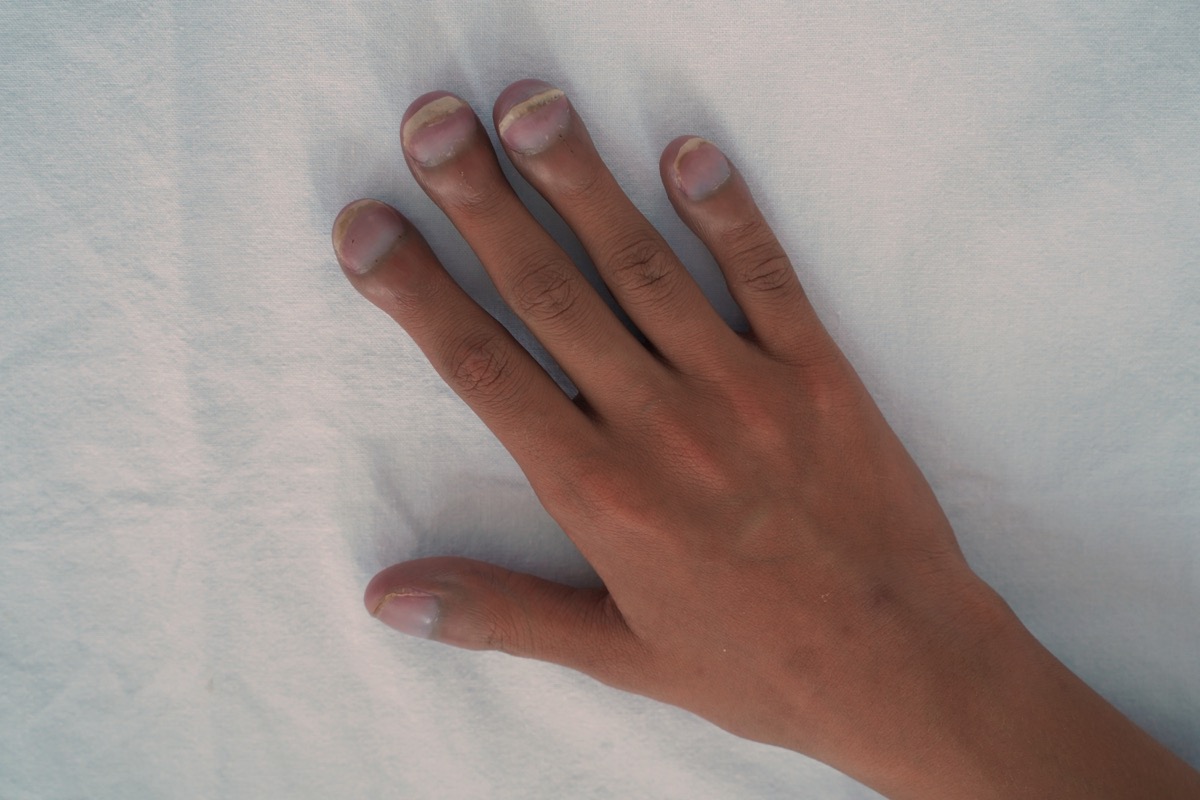Sometimes, you could experience bluish nails due to cold weather that can temporarily cause poor circulation in your extremities, leading to discoloration in the nails. And injuries to the tips of your hands or feet can cause bruises under your nails that can also alter their hue. But if that’s not the case, your nails may be turning blue or purple because there’s not enough oxygen in your blood, which is called cyanosis.ae0fcc31ae342fd3a1346ebb1f342fcb “[Cyanosis] is a symptom of an underlying condition rather than being a disease in itself,” Ananya Mandal, MD, an associate professor at a Government Medical College, explained in News Medical Life Sciences. “Treatment of cyanosis thus focuses on the underlying disease rather than the symptom alone.” Andrew Weil, MD, director of the Andrew Weil Center for Integrative Medicine, suggests seeking medical attention to discover any underlying causes “if blue nails aren’t merely a temporary reaction to cold temperatures.” As Weil explains on his website, “Your physician will probably want to do a simple rapid-blood gas analysis to measure the oxygen in your blood and perhaps some tests to check your heart and lungs.” And for more subtle signs of serious health issues, If Your Breath Smells Like This, Get Your Liver Checked, Experts Say. Many lung conditions, which affect your blood oxygen levels, can cause your nails and fingertips to have a blue tint, including chronic obstructive pulmonary disease (COPD), asthma, pneumonia, acute respiratory distress syndrome (ARDS), and a pulmonary embolism (blood clot), Medical News Today explains. Weil notes that emphysema, which is a form of COPD, and chronic bronchitis are two other underlying conditions that could lead to nail discoloration. A great way to check how much oxygen is in your blood is by using a pulse oximeter, a device that’s placed on the fingertip and uses a light to project oxygen saturation levels, the U.S. Food and Drug Administration (FDA) says. But if you’ve noticed a bluish or purplish tint to your nails that wasn’t due to temperature or injury, you should contact your doctor. And for more helpful health information delivered straight to your inbox, sign up for our daily newsletter. According to Katherine R. Garrity, MD, of Aurora Health Care in Wisconsin, if your fingertips appear to be large and bulging—a symptom known as nail clubbing—it could also be a sign of low oxygen in your blood, and therefore, of lung disease. Mount Sinai Health System explains nail clubbing symptoms include soft nail beds that appear to “float,” fingertips that are warm and red, and nails that curve downward, similar to an upside-down spoon. “It is a pretty characteristic finding and a good diagnostic clue to look at the lungs,” Phoebe Rich, MD, director of the Nail Disorders Clinic at Oregon Health and Science University, told Today in 2018. “It probably has something to do with oxygenation of the tips of the digits, although there’s really no literature that explains it with 100 percent certainty.” Nail clubbing could take years to develop, but in addition to being a sign of lung disease, it could also be an indicator of inflammatory bowel disease, liver disease, HIV/AIDS, thyroid disease, and heart disease, Garrity notes. And for more indicators of health issues on your fingertips, If You See This on Your Nails, It Could Be a Tell-Tale Sign of Diabetes. If it turns out that you don’t have any issues with your lungs, it’s important to know that nail abnormalities can also be a sign of other serious problems. Bluish or purplish nails could be an indicator of congestive heart failure, which can also come with extreme tiredness, swollen extremities, and shortness of breath, experts with Medical News Today explain. And if you’re noticing another color in your nails, it could be a sign of something else. While yellow, brown, or green nails likely are due to a fungal infection, yellow nails could also be a symptoms of diabetes, psoriasis, or a thyroid condition, Healthline explains. Specifically, onycholysis—also known as plummer’s nails—which can turn your nails brown or green, could be a sign of hyperthyroidism. Onycholysis takes place “when the nails pull away from the nail bed beneath it,” Dearbhaile Collins, PhD, a medical doctor at Cork University Hospital in Ireland, previously told Best Life. “Due to the presence of air,” Collins noted, your nail may turn brown or green if infected due to onycholysis. And for other indicator of a thyroid problem, If You Can’t Stop Doing This at Night, Get Your Thyroid Checked.



